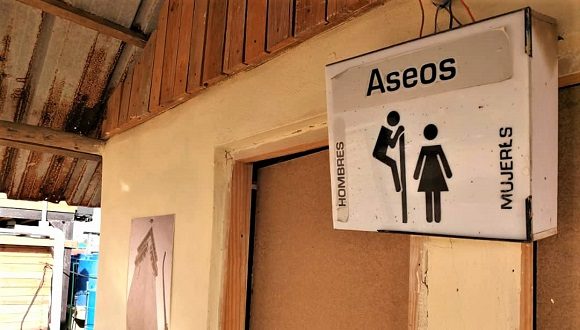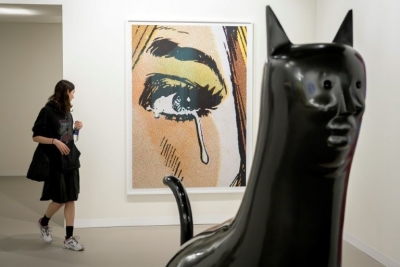Sexual Harassment 3
Chronicle of Harassment Announced

Chronicle of Harassment Announced
 By Dixie Edith
By Dixie Edith
Cuban journalist and professor at the Faculty of Communication of the University of Havana.
On Twitter @Dixiedith
January 16, 2020
Translated and edited by Walter Lippmann for CubaNews.

The pictograms indicate a public bath located in the new recreational space at the intersection of 1st and 70th streets, in the capital city of Playa. Photo: Ariel Terrero.
From a bad joke to sexism is only one step removed. Evidence abounds; it is enough to review, even as the crow flies, various communication spaces, in any format. But what happens when the dubious attempt of a joke, as if that were not enough, makes a crime acceptable?
The question is neither banal nor exaggerated. A few days ago, a group of students from the Communications Department at the University of Havana, had just finished their semester of studies on gender. They were debating via WhatsApp about the photo that accompanies this text. “But what is this?”, some asked. “Doesn’t anyone realize this nonsense?”, asked others.
The photo captured the pictograms that point to a public bathroom located in the new recreational space of the capital’s coast, at the intersection of 1st and 70th streets, in Playa municipality. The figures show a man sneaking a look at a woman, above what looks like the wall that divides the two stalls. And here, the frustrated attempt at a “joke” came and went.
We are no longer talking about old hats: top hats for them and full of flowers or lace for them; or stereotypical film characters showing the gallant and the maiden, the flamenca and the bullfighter. Not even of those other attempts at “creativity” that appeal to phallic symbols, heels or ties, or any other topic tinged with sexism, by the work and grace of the macho tradition that pursues us.
Now we are also witnessing incitement to an act that is punishable under our laws. And, as if this were not enough, it not only positions women once again as the subject – the “natural” victim – of hegemonic masculinity, but also places all men in the position of violators of the law, of victimizers. This is called symbolic violence.
In the opinion of Yamila González Ferrer, a lawyer and expert on gender and family issues, “when what this image is showing occurs, we are dealing with a crime of harassment, provided for in Article 303 of the Criminal Code, which refers to sexual outrage”. But, for her, the most serious thing in this particular case is that “this type of symbolism is used in a public place”.
The aforementioned Article 303 has three subparagraphs, which propose sanctions of up to “three months’ imprisonment” or a “fine of one hundred to three hundred pesos“ for those who harass other persons “with sexual requirements”; offend “modesty or good manners with obscene exhibitions or acts”, or produces or puts into circulation “publications, recordings, cinematographic or magnetic tapes, recordings, photographs or other objects that are obscene, tending to pervert or degrade customs”.
If I were to make a dynamic or evolving interpretation of the law,” says Yamila, “then subparagraph c of that offense of sexual abuse could be applied perfectly well to that case.
Another lawyer, Dr. Arlín Pérez Duarte, agrees with her, in this case an experienced criminal lawyer. In her opinion, this last section applies in this case from what she calls an “analogical interpretation” of the law, since it “appeals to the effects provoked”. The specialist says that, in this matter, “from the point of view of rights, there is a lot of room for improvement”.
For example, criminal implications could be sought from so-called voyeurism or, or as we say jokingly, peeping, which in the eyes of the law is considered a form of outrage or a crime against honor. Although traditionally this type of infraction in Cuba is not punished as a crime, but more as a contravention,. However, in the opinion of the penalist, in this case “it has a greater scope, since it is in an institution that provides a public service”. In other words, it goes beyond affecting an individual person.
The world of signage to label the doors of public toilets and bathrooms serves as a preview of what we will find inside. But it is an soup where multiple proposals are cooked. There are designs that move, between the thorny waters of good and bad taste, the vulgar and really creative. In this unfortunate case, to put more spice to the broth, the half-assed sign also violates Article 40 of the recently approved Constitution of the Republic, which defends human dignity; Article 43, which condemns gender violence in all its forms and Article 48, which defends the right to privacy. And we could continue looking.
Currently, many public discussions around the world are occupied with how to achieve more inclusive signage and urban spaces that do not reproduce those stereotypes that our patriarchal societies have imposed on women and men. There is talk, for example, of unisex toilets, which serve them equally, which would also help not to humiliate or discriminate against other people who have different sexual orientations and gender identities.
If we still find signs like the one in the above mentioned photo, it is clear that we are still far from those other controversies. The unfortunate thing is that the case is not unique. The same students who questioned and argued about the 1st and 70th signs also claimed to have seen similar pictograms in other establishments, especially in the self-employed sector.
As with advertising, urban design, intentionally or not, helps to perpetuate ideas through graphic codes and creative nods. And because machismo is so naturalized in our lives, we often find it hard to identify that behind those seemingly innocent jokes is a deeply violent, threatening message that, according to García Márquez, could become the advertised chronicle of a crime of harassment.
#MeToo at the Basel Fair
 Women Artists Bring #MeToo to the Basel Fair
Women Artists Bring #MeToo to the Basel Fair
By AFP
Sunday, June 16 2019 08:29
Translated and edited by Walter Lippmann for CubaNews.

A work of art by Anne Collier titled “Woman Crying (Comic) #7”, with another by Nicolas Party titled “Big Cat” (right) on display at the Basel Art Fair, the largest in the world.
The #MeToo movement that exploded worldwide in late 2017 inspires several works on display this year at the Basel Art Fair, the largest in the world.
Visitors discover inflatable mannequins in white airbag dresses created to protect women from harassment in the workplace, and details of alleged sexual crimes of some 170 public figures displayed on four long walls dotted with red.
Women artists are at the center of the scene of this 50th edition, with their works and in-your-face installations expressing the anger and exasperation of persistent gender inequalities and the abuses and harassment condemned by society.
The Spaniard Alicia Framis has filled a room with delicate white mannequins with dresses made of airbag material, which are activated to protect different parts of the female body.
The work entitled “Life Dress” consists of dresses to “protect women in all work situations where there is some kind of abuse,” Framis told AFP.
The 52-year-old artist said she spoke with victims of harassment and abuse and her stories inspired the design, using “fashion to protest against violence.
While Framis turns to humor, Los Angeles-based artist Andrea Bowers opts directly for anger with her large archive project “Open Secrets.
It consists of photographic prints with red backgrounds, each mentioning the name and trade of the public figure accused of sexual harassment or abuse, her public response to the accusations, and details of the case.
Culture of Rape
Hollywood ex-producer Harvey Weinstein, whose alleged crimes launched the #MeToo movement, has two full panels dedicated to his long list of alleged crimes.
U.S. President Donald Trump also appears in the work, as do his predecessors Bill Clinton and George Bush senior, two Supreme Court justices, actors, journalists and musicians, among others.
“I think the #MeToo movement is perhaps one of the most important feminist movements of my life,” Bowers told AFP, referring to his inspiration for the play.
Bowers, 54, who presents herself as a feminist activist artist, said she was shocked to realize “what it was like growing up for me in that culture of rape where young men were allowed to sexually rape me and my friends.
With the #MeToo movement, this kind of behavior is finally “being recognized,” she said. “I hope it’s a historic change.
During the premiere earlier in the week, many men stopped in front of the work that covers two wide walls, on both sides, in the middle of the fair’s large exhibition space.
“You can see a lot of men standing here and a little insecure about how to react,” said Vanja Oberhoff, a young German art investor. “It’s a very powerful work,” he told AFP.
But not all reactions are positive.
Helen Donahue, who in 2017 tweet photographs of her body with marks for alleged abuse by independent columnist Michael Hafford, expressed indignation that Bowers used one of her images.
“It’s great that my damn photos and trauma are headed to the Basel fair. Thank you for exploiting us for the +arte+ ANDREA BOWERS,” he tweet Thursday.
Bowers, who insists on the importance of trusting survivors, quickly issued an apology for not asking Donahue’s permission before using the photo and removed the panel from his exhibit.
Debate on sexual harassment
SEMlac
Harassment Debate Asks Men to Put Themselves in Women’s Place
From the Editors. April 15, 2019
Translated and edited by Walter Lippmann for CubaNews
 Fear, shame, fright, confusion, astonishment and discomfort in the face of the situation are just some of the reactions that several Cuban men said they felt when they were harassed in the street by a woman. Such unusual scenes are part of a social experiment carried out by the Oscar Arnulfo Romero Center (OAR), which toured the networks in the form of a video and reflects what happens when harassment occurs the other way around and it is women who verbally “assault” men.
Fear, shame, fright, confusion, astonishment and discomfort in the face of the situation are just some of the reactions that several Cuban men said they felt when they were harassed in the street by a woman. Such unusual scenes are part of a social experiment carried out by the Oscar Arnulfo Romero Center (OAR), which toured the networks in the form of a video and reflects what happens when harassment occurs the other way around and it is women who verbally “assault” men.
At phrases like “you’re super cute,” “how hot you are,” “I didn’t want to know the time, what I wanted was to talk to you, mess with you because you’re divine,” or “kidding, but please believe me,” the men who were harassed felt assaulted in various ways, as they said after being informed that it was a hidden video.
“I was ashamed to see a young girl, pretty, giving herself away, saying: look, I want to go out with you, because it’s very strange”, said one of the interviewees.
Another of them claimed to have “gone blank” at the approach of a stranger, while a third said “he felt attacked, because the form and the words he used were not correct”. She added, however: “with harassment there is nothing right, everything is unpleasant, it goes against the integrity of the person”.
“I thought I was crazy, because the man is the one who always harasses the woman, not the woman harassing the man”; or “I got scared, I felt nervous, this is the first time this has happened to me” were feelings that the experiment generated for them.
According to statements by Juan Carlos Travieso, director of the video social experiment, the purpose of this initiative is “to put men in the place where women usually are and then in the place where men are almost always.
“We are trying to make people think about and respect the individuality and integrity of human beings, so that everyone can decide what to do with their body, who touches it or not,” said the director.
The controversy about what to understand by sexual harassment also emerged from the comments of the men interviewed. This was in the face of ideas such as their dependence on the way in which they address women, or the conception of the so-called compliment as “something of our idiosyncrasy that should not be lost, as long as it is said in a nice way, with respect”.
“Harassment is a crime, but it is not the same to interfere with them as in fooling around than to harass them” or “it depends on the woman, in the way in which it is done: it is not the same as a compliment or disrespect” were other opinions of the men, many of whom agreed that harassment is not seen well in a woman, but in men it is “normal”.
This social experiment is an idea of the members of OAR’s Youth Articulation Network and is linked to the approaches of the Evoluciona campaign, which conceives street harassment as an expression of male violence.
Widely socialized on the networks in recent days, its publication coincided with the International Week against Street Harassment, an initiative that was born in Peru in 2011, and seeks to inform women about their rights and condemn any form of sexual violence in the street.
For journalist Dainerys Mesa Padrón, who is a member of the campaign team, this experiment opens the fingerboard on an edge of women’s body control and social relations. At the same time, it contributes to the discussion of street harassment in Cuba and its naturalization [acceptance], because it is associated with traditional cultural practices.
“It is essential to change the belief that our self-esteem depends on compliments, on an opinion about our body or clothes in order to feel good. [These are] ideas that most people assume to be normal, when it is a clear symptom of violence against women,” she said in the making of the video.

Harassment vs. compliments: daily acceptance of violence
One of the expressions of gender violence is sexual violence and, within it, sexual harassment is one of the most invisible, minimized, legitimized and silenced forms of violence, psychologist Mareelén Díaz Tenorio, an OAR specialist, told SEMlac.
According to the expert, sexual harassment practices are very diverse and range from sexual approximation, demand for sexual favors, insinuations, physical contacts (touching, pinching, talking in the ear, overlapping, grabbing, touching, patting, squeezing, deliberate rubbing), to teasing and jokes with sexual and offensive content.
This group also includes telephone calls, notes, letters, texts, photographs, emails with sexual and aggressive content (through cell phones and cyberspace); the display of pornographic material; lewd looks; obscene gestures; exhibitionism: showing one’s genitals or naked body to another person without their consent; public masturbation with or without ejaculation and cornering, among others.
“We are talking about various practices of a sexual nature and connotation, unwanted and offensive, that do not consider the impact on the recipient. They are intrusive and have repercussions for physical and psychological integrity,” she said.
The psychologist indicated that the contexts in which sexual harassment occurs can be institutional (work, educational, religious), family, public and social networks (cyber-harassment).
Street harassment occurs precisely in public spaces. “It is carried out by unknown people and it is less visible because it is legitimized by culture,” she said.
The specialist points out that there is great controversy about what is meant by sexual harassment and compliments. In her opinion, not all compliments are sexual harassment.
“It is supposed that compliment is a compliment and ceases to be a compliment to become sexual harassment when the action is unwanted and is experienced with annoyance, displeasure, affectation, harm, even when its content is not offensive, vulgar or obscene. There is no good compliment and no bad compliment. There is a compliment and sexual harassment,” she emphasized.
“Many people legitimize the compliment at all costs because they consider it a cultural tradition in the Cuban context. The ablation of the clitoris is a practice of certain cultures and does not stop being extreme sexual violence,” said Díaz Tenorio.
In her opinion, there is a social imaginary in which women exist as objects of sexual desire and it is “normal” to judge their bodies and use them without their consent. In the public space, practices are seen as “natural” that cannot be cataloged as compliments, but as authentic expressions of sexual harassment. If they are not recognized as such, we are guaranteeing their perpetuity, their injustice and the harmful consequences for the victims (not only women, but also girls), she said.
For María Teresa Díaz Álvarez, also an OAR specialist, the so-called compliment becomes street harassment when it involves insult, imposition, and the intention to bend. “Then it becomes a pattern of abuse,” she warned.
Oxfam’s report “Breaking the Moulds: Transforming Imaginaries and Social Norms to Eliminate Violence” found that among the young Cuban population, “complimenting” women is still seen as logical and normal.
With the participation by Cuba in the Center for Psychological and Sociological Research, in collaboration with OAR and Oxfam in Cuba, the investigation concluded that 75 percent of young people between the ages of 15 and 25 accept street harassment (whistles and compliments) as natural.
The study delved into youth images regarding violence against women and points out that more than 81 percent of girls and boys think that most of their friends see this behavior as normal.
On the other hand, several young people from different age groups and territories linked these demonstrations with provocative actions by women in their attitude and way of dressing. Others placed responsibility on the beliefs and social norms that condition these machista and stereotyped practices.
Liset Imbert Milán, OAR’s legal advisor, told SEMlac that harassment is not expressly regulated today, as it does not appear in any legal norm. [there’s no law against it, ed.]
She pointed out that the new Magna Carta endorsed last February opens the doors in its article 43 to improve and include these issues in the rest of the laws, insofar as it states that “it protects from gender violence in any of its manifestations and spaces, and creates the institutional and legal mechanisms for it”, and harassment is a form of violence.
Beyond legal remedies, it is a question of making the phenomenon visible, since in the workplace the employer’s obligation to ensure the physical, moral and psychological integrity of workers is regulated, while in the criminal field, from the extensive interpretation of the jurists, it could be used as a means of ensuring the physical, moral and psychological integrity of workers.
“However, much remains to be done, not only in terms of rules, but also in raising awareness among law enforcement officials and law enforcement officials, as well as empowering and giving a legal culture to society in general,” the jurist stressed.
In this regard, the Evoluciona campaign has found echo in many voices, individuals, groups and institutions that join the strategy of awareness, largely youth, in the opinion of Diaz Tenorio.
“Of course there is resistance. But the inert is not the polemic. The indolent would be the absolute acceptance of harassment as `natural´ and indifference. If there is controversy we are on the road to change, which will occur when the insertion of women’s rights in the multiple ways of education and spaces of socialization of the country,” said the expert.
In addition to the social experiment, broadcast on television and social networks, during the International Week against Street Harassment, workshops were held on communication and equity, exchanges with young people from the University of Havana, polytechnic and pre-university students from territories such as Jobabo, in the eastern province of Las Tunas.
The social networks were flooded with messages from audio-visual directors, singers, journalists and other opinion leaders about why street harassment should be eliminated, generating multiple comments and positioning interesting like #PonteEnMiLugar.
Subscribe to Blog via Email
| M | T | W | T | F | S | S |
|---|---|---|---|---|---|---|
| 1 | 2 | 3 | 4 | 5 | 6 | 7 |
| 8 | 9 | 10 | 11 | 12 | 13 | 14 |
| 15 | 16 | 17 | 18 | 19 | 20 | 21 |
| 22 | 23 | 24 | 25 | 26 | 27 | 28 |
| 29 | 30 | 31 | ||||

You must be logged in to post a comment.